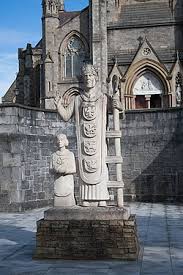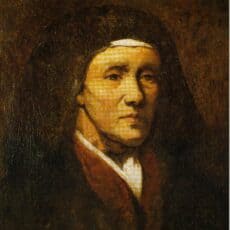
By Johnny McLaughlin,
March 11, 2025
Saint Macartan is one of the earliest known Irish saints, a direct convert of Saint Patrick and
one of his closest friends. Macartan was born in Northern Ireland, sometime in the
early-to-mid fifth century.
His first name was Aedh, and the son of a chieftain named Caerthen, which translates to Rowan Tree. There is no definitive source as to who exactly his father was or where he ruled, but we can make a good guess that he was near modern-day County Londonderry, as the Ui Maicc Cairthinn clan existed as a sept of the Airgialla kingdom.
This kingdom also included what would become the diocese of Clogher, of which Saint Macartan is
heavily associated.
St. Patrick began his preaching in Ireland when Macartan grew into adulthood. He
traveled south to Drumlease in modern-day County Leitrim to hear St. Patrick speak.
After hearing Patrick’s preaching, Macartan was baptized a Christian and became one of his traveling companions. Different sources give him different titles: The Staff of Patrick, the Strong Man of Patrick, and the Champion of Patrick. All of these were given to him due to his zeal for spreading the faith across Ireland and for his physical strength. In effect, he was St. Patrick’s bodyguard while the saint traveled.
Often, St. Patrick would get exhausted during his preaching, and Macartan was there to
assist. As St. Patrick grew in age, he also became more frail, and he preached to the pagans of
Ireland grew tiresome. Macartan would assist him in his old age, up to and including literally
carrying the old man over rivers and rough terrain. Patrick would lean on him like a staff, hence
one of his titles.
As Macartan aged, he too could not assist Patrick in his endeavours.
Finding sympathy for his old friend, St. Patrick granted him his wish to build a monastery in
Clogher, and finish his remaining years there. It was here that Macartan became the first bishop
of Clogher, one of the oldest bishoprics in Ireland.
As a parting gift, Patrick gave Macartan a wooden reliquary. This reliquary, known today as
the Domnach Airgid, or Silver Church, is said to have contained many relics, including a tuft of
Mary’s hair and fragments of the True Cross. It contains today fragments of sheets containing
the Gospels. It has some of the earliest surviving metalwork images of St. Patrick. The
Domnach Airgid was moved from place to place until it was finally transferred to the National
Museum of Ireland in Dublin, where you can see it today.
Another artifact associated with St. Macartan is the Golden Stone, or the Cloch-Or. It is
the artifact from which the Diocese of Clogher takes its name. It is believed to be a ceremonial
or oracle stone covered in gold, and was held sacred to the druids. The legend says that after
Macartan built his monastery, a local pagan ruler harassed him. However, Macartan persisted
with patient love, showing nothing but Christian charity to the pagan. It was through this
perseverance that the chieftain was won over and converted. As a gift, he presented Macartan
the Golden Stone. This stone is preserved in the Church of Ireland Cathedral in Clogher village,
County Tyrone.
Saint Macartan died of natural causes in 506, in his monastery in Clogher. He is the patron
saint of Clogher Diocese, which still exists today. His feast day is March 24, a full week after St.
Patrick’s Day.
Saint Macartan, pray for us!


